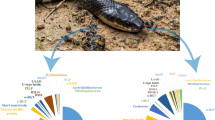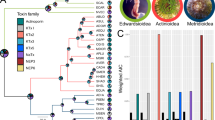Abstract
More than 400,000 people each year suffer adverse effects following bites from venomous snakes. However, snake venom is also a rich source of bioactive molecules with known or potential therapeutic applications. Manually ‘milking’ snakes is the most common method to obtain venom. Safer alternative methods to produce venom would facilitate the production of both antivenom and novel therapeutics. This protocol describes the generation, maintenance and selected applications of snake venom gland organoids. Snake venom gland organoids are 3D culture models that can be derived within days from embryonic or adult venom gland tissues from several snake species and can be maintained long-term (we have cultured some organoids for more than 2 years). We have successfully used the protocol with glands from late-stage embryos and recently deceased adult snakes. The cellular heterogeneity of the venom gland is maintained in the organoids, and cell type composition can be controlled through changes in media composition. We describe in detail how to derive and grow the organoids, how to dissociate them into single cells, and how to cryopreserve and differentiate them into toxin-producing organoids. We also provide guidance on useful downstream assays, specifically quantitative real-time PCR, bulk and single-cell RNA sequencing, immunofluorescence, immunohistochemistry, fluorescence in situ hybridization, scanning and transmission electron microscopy and genetic engineering. This stepwise protocol can be performed in any laboratory with tissue culture equipment and enables studies of venom production, differentiation and cellular heterogeneity.
This is a preview of subscription content, access via your institution
Access options
Access Nature and 54 other Nature Portfolio journals
Get Nature+, our best-value online-access subscription
$29.99 / 30 days
cancel any time
Subscribe to this journal
Receive 12 print issues and online access
$259.00 per year
only $21.58 per issue
Buy this article
- Purchase on Springer Link
- Instant access to full article PDF
Prices may be subject to local taxes which are calculated during checkout




Similar content being viewed by others
Data availability
All previously unpublished data is included in the figures. Raw image files are available from the corresponding author upon request.
References
Sato, T. et al. Single Lgr5 stem cells build crypt-villus structures in vitro without a mesenchymal niche. Nature 459, 262–265 (2009).
Kretzschmar, K. & Clevers, H. Organoids: modeling development and the stem cell niche in a dish. Dev. Cell 38, 590–600 (2016).
Clevers, H. Modeling development and disease with organoids. Cell 165, 1586–1597 (2016).
Gutierrez, J. M. et al. Snakebite envenoming. Nat. Rev. Dis. Primer 3, 17063 (2017).
Sells, P. G., Hommel, M. & Theakston, R. D. G. Venom production in snake venom gland cells cultured in vitro. Toxicon 27, 1245–1249 (1989).
Carneiro, S. M. et al. Venom production in long-term primary culture of secretory cells of the Bothrops jararaca venom gland. Toxicon 47, 87–94 (2006).
Yamanouye, N. et al. Long-term primary culture of secretory cells of Bothrops jararaca venom gland for venom production in vitro. Nat. Protoc. 47, 87–94 (2007).
Post, Y. et al. Snake venom gland organoids. Cell 180, 233–247.e21 (2020).
Sato, T. et al. Long-term expansion of epithelial organoids from human colon, adenoma, adenocarcinoma, and Barrett’s epithelium. Gastroenterology 141, 1762–1772 (2011).
Boj, S. F. et al. Organoid models of human and mouse ductal pancreatic cancer. Cell 160, 324–338 (2015).
Schutgens, F. et al. Tubuloids derived from human adult kidney and urine for personalized disease modeling. Nat. Biotechnol. 37, 303–313 (2019).
Nicolas, J. et al. Detection of marine neurotoxins in food safety testing using a multielectrode array. Mol. Nutr. Food Res. 58, 2369–2378 (2014).
Whiteley, G. et al. Defining the pathogenic threat of envenoming by South African shield-nosed and coral snakes (genus Aspidelaps), and revealing the likely efficacy of available antivenom. J. Proteomics 198, 186–198 (2019).
Slagboom, J. et al. High throughput screening and identification of coagulopathic snake venom proteins and peptides using nanofractionation and proteomics approaches. PLoS Negl. Trop. Dis. 14, e0007802 (2020).
Muraro, M. J. et al. A single-cell transcriptome atlas of the human pancreas. Cell Syst 3, 385–394.e3 (2016).
Baran-Gale, J., Chandra, T. & Kirschner, K. Experimental design for single-cell RNA sequencing. Brief. Funct. Genomics 17, 233–239 (2018).
Dekkers, J. F. et al. High-resolution 3D imaging of fixed and cleared organoids. Nat. Protoc. 14, 1756–1771 (2019).
Drost, J., Artegiani, B. & Clevers, H. The generation of organoids for studying WNT signaling. Methods Mol. Biol. 1481, 141–159 (2016).
Fujii, M., Matano, M., Nanki, K. & Sato, T. Efficient genetic engineering of human intestinal organoids using electroporation. Nat. Protoc. 10, 1474–1485 (2015).
Lu, Y. et al. Avian-induced pluripotent stem cells derived using human reprogramming factors. Stem Cells Dev. 21, 394–403 (2012).
Peng, L. et al. Generation of stable induced pluripotent stem-like cells from adult zebra fish fibroblasts. Int. J. Biol. Sci. 15, 2340–2349 (2019).
Pierzchalska, M., Panek, M., Czyrnek, M. & Grabacka, M. The three-dimensional culture of epithelial organoids derived from embryonic chicken intestine. Methods Mol. Biol. 1576, 135–144 (2019).
Acknowledgements
We thank A. de Graaff and the Hubrecht Imaging Centre (HIC) for microscopy assistance; B. Ponsioen for providing a lentiviral H2B-RFP construct; and local snake breeders as well as W. Getreuer and SERPO for donating venom gland material.
Author information
Authors and Affiliations
Corresponding author
Ethics declarations
Competing interests
H.C. is inventor on multiple patents held by the Dutch Royal Netherlands Academy of Arts and Sciences that cover organoid technology: PCT/NL2008/050543, WO2009/022907; PCT/NL2010/000017, WO2010/090513; PCT/IB2011/002167, WO2012/014076; PCT/IB2012/052950, WO2012/168930;PCT/EP2015/060815, WO2015/173425; PCT/EP2015/077990, WO2016/083613; PCT/EP2015/077988, WO2016/083612; PCT/EP2017/054797,WO2017/149025; PCT/EP2017/065101, WO2017/220586; PCT/EP2018/086716; and GB1819224.5. H.C.’s full disclosure is given at https://www.uu.nl/staff/JCClevers/.
Additional information
Peer review information Nature Protocols thanks C. Caldeira, J. Calvete and C. M. Trim for their contribution to the peer review of this work.
Publisher’s note Springer Nature remains neutral with regard to jurisdictional claims in published maps and institutional affiliations.
Related links
Key reference using this protocol
Post, Y. et al. Cell 180, 233–247.e21 (2020): https://doi.org/10.1016/j.cell.2019.11.038
Supplementary information
Rights and permissions
About this article
Cite this article
Puschhof, J., Post, Y., Beumer, J. et al. Derivation of snake venom gland organoids for in vitro venom production. Nat Protoc 16, 1494–1510 (2021). https://doi.org/10.1038/s41596-020-00463-4
Received:
Accepted:
Published:
Issue Date:
DOI: https://doi.org/10.1038/s41596-020-00463-4
This article is cited by
Comments
By submitting a comment you agree to abide by our Terms and Community Guidelines. If you find something abusive or that does not comply with our terms or guidelines please flag it as inappropriate.



